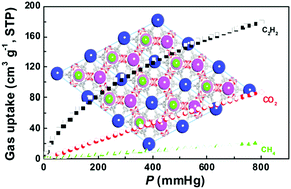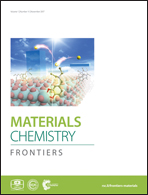A family of ssa-type copper-based MOFs constructed from unsymmetrical diisophthalates: synthesis, characterization and selective gas adsorption†
Abstract
In this work, three porous MOFs (ZJNU-74, ZJNU-75 and ZJNU-76) were constructed via solvothermal reactions of unsymmetrical naphthalene-derived diisophthalate ligands and Cu2+ ions. As revealed by single-crystal X-ray diffraction analyses, they consist of dicopper [Cu2(COO)4] paddlewheels connected by the organic ligands to form three-dimensional networks with the same ssa topology, thus representing a MOF platform which allows understanding of the structure–property relationship. The gas adsorption properties of the three MOF compounds with respect to C2H2, CO2 and CH4 have been systematically investigated. They exhibit very high C2H2 uptakes varying from 179.2 to 188.6 cm3 (STP) g−1 and CO2 uptakes varying from 88.1 to 99.2 cm3 (STP) g−1 at 298 K and 1 atm. The predicted IAST selectivities range from 24.9 to 29.7 for an equimolar C2H2/CH4 gas mixture and from 4.8 to 5.4 for an equimolar CO2/CH4 gas mixture at 298 K and 1 atm. These results reveal that they possess very promising potential for C2H2/CH4 and CO2/CH4 separations. In particular, compared to the unmodified parent MOF ZJNU-74, the alkoxy group-functionalized MOFs ZJNU-75 and ZJNU-76 exhibit comparable and even higher C2H2 and CO2 uptake capacities as well as better C2H2/CH4 and CO2/CH4 adsorption selectivities under ambient conditions, which might be attributed to the optimized pore sizes as a result of ligand modification.



 Please wait while we load your content...
Please wait while we load your content...